
The Scourge of History
The colonial era,
Gondwana's nightmare
My first three long bicycle tours away from my home country took place in New Zealand, Cuba, and Madagascar. After I had completed those interesting tours, I realized that there were some readily apparent differences in the modern fabric of their societies that likely resulted from their distinct histories as colonies of Britain, Spain, and France, respectively. At the time, I thought about writing an article to be titled: "Tours of the Colonial Islands."
However, as often happens, other things got in the way of that idea and I never got around to starting the project. That may have turned out for the best, as the Tour of Gondwana gave me a much broader perspective on the topic of colonialism and its modern ramifications than I have ever had before. Most of the territory over which I rode was claimed by one or more of the European colonial powers at some point during the era when such geopolitical transgressions were the order of the day. Though I had learned about that period in history when I was a student, back at a time when the topic was usually glorified, and have read much on its aftermaths since then, visiting the lands that were once colonies provided an experience with much more impact than anything I had learned previously. My opinions on the topic of colonialism can be summed up fairly directly: I cannot think of one good thing to say about the practice. To begin, an image from one of those first tours is relevant, The Cruz de la Parra, an artifact displayed in Baracoa, Cuba that is said to have been left there by Christopher Columbus himself, the man who's voyages mark the beginning of that dreadful period.
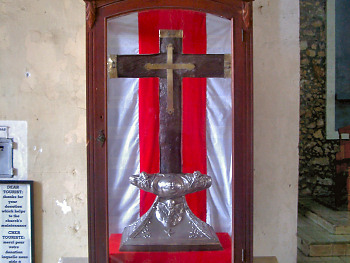
The Cruz de la Parra, said to be left by Columbus at Baracoa, Cuba
A 500-Year Disgrace
While most of the lands of Gondwana were smothered by the blanket of the colonial enterprises, the locations, dates, and occupying nations varied on the various continents. In general, the colonial occupations came in waves, targeting different portions of the globe with each crest. In the first such period of conquest, the Americas took the brunt of the damage, though there were also smaller colonies established in other places, including the coasts of Southern Africa and the Far East. It was only around forty-five years after the first landing of the Santa Maria and its sister ships on Hispanola, a mere single adult lifespan, before all of the major civilizations of the Americas were gone, with all the smaller cultures following suit shortly thereafter. Not surprisingly, many descendants of colonists over the years have looked upon the first contact as an event to be celebrated, which may explain why it is not hard to find statues like the ones shown below. The sculptures show a grand, paternalistic Columbus steadying a cowering "Indian" girl, as if to calm her anxiousness over the impending arrival of a new, world of civilized pleasures and fabulous wealth. One must wonder, if the truth had been revealed to the girl at the time, whether a somewhat more disturbing pose would have been required in future statues.
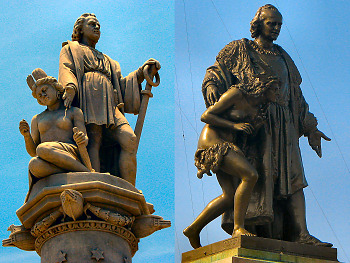
Christopher Columbus Statues in Cartageņa, Colombia and Colon, Panama
With such a bounty secured, the major powers were perhaps distracted from additional conquests for a considerable length of time. Once the American colonial zone had wrested its independence from Europe, however, the desire for new territory did not diminish and the second wave, occurring around the start of the 19th century, involved expansions of the South Asian colonies to encompass essentially the whole of that region. The third and final wave deserves special mention, which will follow below. In this region of the world the conquerors frequently saw themselves as saviors, just as their earlier counterparts in the western hemisphere had. The Viceroy's Gate in the former Portuguese enclave of Goa, in India, displays a suitably heroic likeness of Vasco da Gama, who was the first to reach the coast of India via the Cape of Good Hope route. On the reverse side of the arch is a somewhat smaller, but more telling, artifact, a sculpture depicting the "Christian victory over paganism", which depicts a royal-appearing woman standing on the back of a prostrate "native."

Vasco da Gama statue on the Viceroy's Gate, Panaji, Goa, India
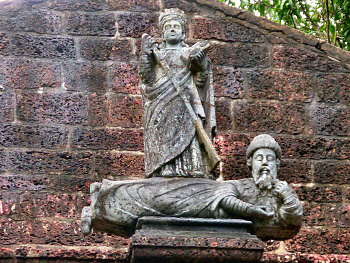
Portuguese colonial carvings on the Viceroy's Gate
The apparent belief that the arrival of the colonial regime would be a tremendous benefit to the current populations of the distant lands seems to have been a unifying thread among those who sought to supplant a preexisting society with their own. Though there seems to have been some noticeable distinctions in the additional motivations ascribed to the various colonizing nations, at least as far as I could determine. Spain seemed to be primarily interested in extraction of wealth, and evangelizing their religion. Britain, especially in its early colonial ventures, appeared to want to create copies of itself in distant lands, and to be able to send settlers there. Portugal and the Netherlands, exhibited a strong desire for trade and commerce, as may have been expected for fairly small, seafaring nations. France probably sought a little of all of these aspects, but also prestige and an opportunity to spread its culture worldwide. With such less-than-noble goals, it is little wonder that things did not generally turn out as planned, especially for those who would become subjugated to those powers.
Thanks For Your Resources
One of the most obvious detrimental relationships between the occupying power and its colony was the extraction of valuable natural resources. In the earliest stages of the colonial era this was done without even the slightest hint of anything that might resemble compensation to the inhabitants of the territory for the removal of the endowments of their home. Nowhere better illustrates those parasitic connections than the city of Potosi, Bolivia. Founded by the Spanish in 01546 as mining town, the city literally struck it rich when the towering mountain at its side, Cerro Rico, literally, the "Rich Mountain" was found to contain one of the largest silver deposits the World has ever known. The historic painting shown below, now on display in the Casa Moneda museum in the old quarter of the city, portrays the bond between the mountain and the city. Riches appear to have been placed in the peak with divine assistance, and the land then gladly surrenders its stores for the benefit of the Spanish crown and church.
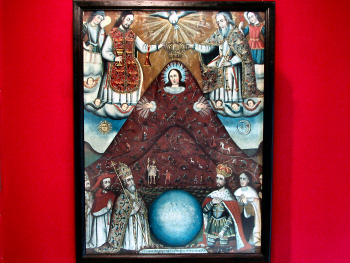
A painting depicting the Cerro Rico silver mines, Potosi, Bolivia
Obviously, the removal of tons upon tons of silver at a frigid elevation of 4,300 meters was no simple process. Undaunted by mere geography in their quest for wealth, the colonial authorities resorted to slave labor to perform the hazardous extractions. When the local supply of slaves seemed inadequate, additional unwilling workers were brought from various parts of Africa. The fact that the latter type of slaves, accustomed to lower, more tropical conditions, did not adapt well to work in the mines must have been intensely frustrating to those interested in exploiting the mountain as quickly as possible. As such, the African slaves were moved to domestic duties, either in the homes of Potosi's wealthy, or in the elegant administrative city of Sucre, where the colonial rulers resided comfortably at a more "appropriate," less lofty, elevation, or on plantations in the subtropical Yungas region further down towards lowlands. Though most of the silver is now gone, miners still work the hill today, seeking the last remaining veins and the deposits of less valuable minerals. Conditions are modestly better today, but far from adequate, and the miner's life at Cerro Rico is a perilous and often unhealthy one. Estimates of the lives lost in the mine since its inception are in the millions.
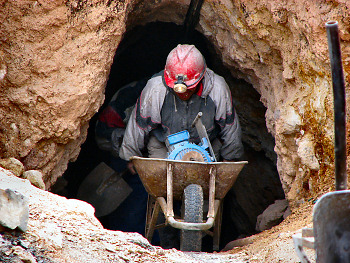
Miners emerging from Cerro Rico, Potosi
Of course, very little of the bounty taken from the mountain was used to enrich the colony of Bolivia–actually, "Alta Peru," at that time–and certainly none was used to aid those who had lived there for millennia. Instead, a mint was built in Potosi and coins were produced with the silver freshly removed from the mountain. Those were shipped back to Spain in chests similar to the one shown below. Actual "treasure chests," sent, one after another, across the Atlantic.
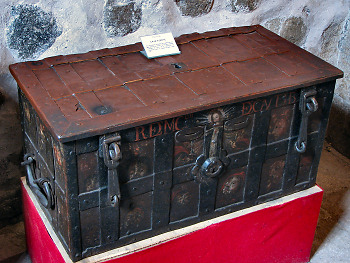
Strong box used to ship silver from Potosi to Spain
Spain is a long way from Potosi, of course, and transporting the riches, which a divinely-filled mountain has so graciously provided you, across abroad ocean is a process fraught with danger. Most of the haul of precious metals, and other treasures from the Andes, were transported by sea, with only one obstacle, the Isthmus of Panama, in the way. Spain must certainly have considered itself fortunate to have conquered that territory as well, though prudence would dictate that appropriate steps be take to protect their newly acquired treasure as it crossed that narrow strip of land. The Castillo San Lorenzo, built at the mouth of the Rio Chagres, the main route across the Isthmus, was built for just that purpose.
The same story could have been written for numerous other places and numerous other commodities scattered about the colonial world. The end would always be similar; a transfer of wealth from an ancient society, usually one on Gondwana, directly to Europe.
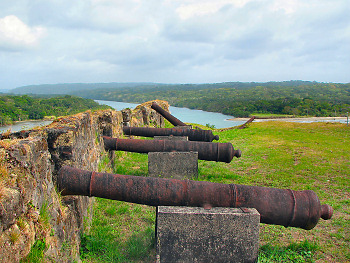
Castillo San Lorenzo at the Rio Chagres, Panama
Sorry About Your Culture
Equally troublesome to the practice of stripping resources, without producing anything of lasting value to the lands from which they were taken, was the typical consequence of wiping out the indigenous culture of the colony, either overtly or inadvertently. Whether intentional, or not, hardly matters now, as almost universally the colonizers considered the culture of the conquered land to be essentially worthless. This reveals a flaw common in human nature, where one's societal structure, as well as other personal conditions, is assumed to be the best possible arrangement, simply because it validates a person's belief in their own level of importance. Whether of not the validity of that belief is correct is rarely questioned. The conquerors obviously felt this way, assuming the European way of life must be superior to all others and that the people of the lands they intended to colonize should be grateful to have an alien civilization imposed on top of their own. This can be seen in the art of the period, examples of which I was able to observe in museums from time to time, which characterized the colonists as heroic figures and the indigenous peoples as ignorant savages.
Of course, that description seldom fits the actual circumstances of the parties involved, and a prime example of that situation would be India. That large and diverse subcontinent spawned one of Earth's oldest civilizations, the Indus valley civilization, thousands of years ago, and its ensuing offspring have flourished essentially continuously since then. In the centuries before British colonization, the region had produced exceptional literature, art, and architecture, the latter exemplified by buildings such as the Agra Fort, shown below. Irregardless of that fact, the British sought to modify the society to become one more to their liking. One rather minor, but obvious example of that was the anglicizing of geographic place names, a modification which is only now, often begrudgingly in the outside world, being reversed. I visited Chennai, not Madras; Mumbai, not Bombay. However, even the full weight of the British Empire could not overcome the collective culture of a region that would reach a population of one billion soon after independence, and today India still appears more Indian than English.
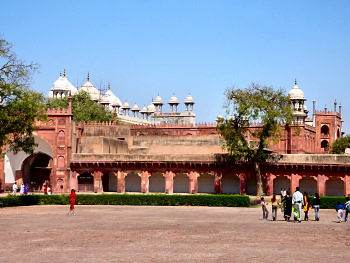
Agra Fort, Agra, India
Other regions were not so fortunate, and those with small indigenous populations, or where colonization involved large numbers of settlers being sent from the occupying nation, often lost much of their original culture. This can be illustrated nicely by a comparison of the effects of colonization on Australia and New Guinea. The former had been home to a wide variety of societies of semi-nomadic people for at least forty thousand years. However, in such an arid environment those cultures were never heavily populated, and were unable to resist the influx of settlers, and convicts, sent from Britain in the early 19th century. The culture and ancient oral history of the aborigines came perilously close to vanishing forever. Neighboring New Guinea, on the other hand, with societies equally old, and genetically close, to their Australian counterparts, was colonized relatively lately and in a less than fervent manner. The important distinction was that there were almost no European settlers sent to live in New Guinea. Today the citizens of Papua New Guinea retain much of their ancient traditions, while being able to, at least somewhat deliberately, decide which facets of the modern world to incorporate into their society. Though that is still a daunting prospect, New Guinea should be recognizable as a distinct society for some time to come.
Another factor that potentially threatened indigenous cultures with extinction was the level of religious zeal exhibited by those ruling the colonizing power. While there was a certain amount of colonization launched from the Islamic world, most of the countries of the Tour were subjugated by European powers, and that meant that Christianity would be brought along for the ride. The level of disdain for viewpoints other than their own is a peculiarity common in adherents to that system, which is hard to reconcile with its fundamental principles, and the missionaries who fanned out around the globe to force their ideas upon others took that attitude to unprecedented heights. The Jesuits' efforts to "civilize" the Guarani people of the Rio Parana area of South America was a particular curiosity in that regard. They did achieve some notable advantages for the Guarani, such as protection form the slave trade and a level of education unheard of for other converted peoples. However, in the process many of the practices and traditions of the pre-colonial Guarani people were lost or pushed to the very fringes of their former world. Interestingly, the Guarani language escaped oblivion far more than most indigenous languages, and today is one of the official languages of Paraguay. Other indigenous cultures were more thoroughly Christianized, however, and we know even less of their traditions today.

Jesuit mission ruins at Trinidad de la Parana, Paraguay
One strategy for cultural preservation that seemed to work in some areas was to incorporate aspects of one's own culture into the rituals and practices imposed by the colonial regimes. The mountainous areas of South America and Mexico were places where such trickery proved to be particularly effective. To an outsider, like me, it is sometimes hard to discern, but many of the nominally Catholic festivals and processions common in that region are laced with metaphors and stories form pre-colonial times, often which put forth ideas that would assuredly be unpalatable to mainstream Christianity. This practice also provided an opportunity to mock one's oppressors, at least for a little while, as evidenced by the masks shown below, from Zacatecas, Mexico, which unflatteringly portray Spanish officers.
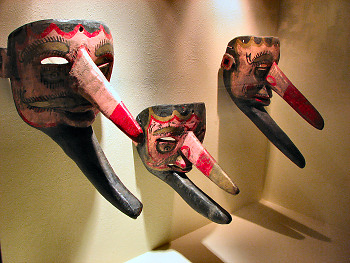
Masks characterturize Spanish colonials; in the Rafael Coronel Museum,
Zacatecas, Mexico
That the colonial experience laid waste to the culture of many nations is immediately revealed when one visits the four countries of the Tour that were never significantly colonized, Thailand, Bhutan, Nepal, and Ethiopia. In each case these lands retain their traditions and culture to a much greater degree than their neighbors that were colonized. Each uses its own language, with its own alphabet; distinctive local cuisines dominate the menus; and literature, art, theater, and music all exhibit classic themes from the traditions of the land. Any attempt to claim that these four countries had been economically disadvantaged for never living under the auspices of a colonial power is easily dismissed. While most could not be described as wealthy nations today, when compared to their colonized neighbors the amount and quality of infrastructure, and most of the other trappings of modern society, are barely distinguishable. Indeed, Thailand has probably been the most modernized nation in Southeast Asia for quite some time.
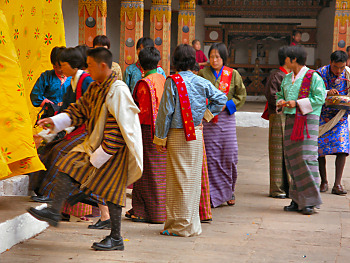
Preparations for a traditional festival at Punhaka Dzong, Bhutan
The Scramble For Africa
The third wave of colonization, alluded to above, merits special mention. Termed the "Scramble for Africa" in reference to the hasty, but complete, partitioning of the bulk of the continent among the various European colonial powers, this attempt to more orderly distribute the lands between them proved to be perhaps the most thoroughly bungled such effort in history. With the first epoch of colonialism generally ending badly, it is rather hard to believe that the nations of Western Europe continued to possess much of an appetite for the whole colonial process. However, the loss of the original colonies, thanks to the desire for independence of the settlers who migrated there, did not seem to diminish the allure or prestige associated with dominion over a distant land. In fact, the number of participants increased in the late 19th century, with Belgium, Italy, and Germany joining the game, and the pace of dismemberment of the only remaining uncolonized land, Africa, reaching a fevered pitch.
The dramatic foundations for the ruination of that continent came during the brief "Congo Conference", otherwise known as the Berlin Conference of 01884. With all the major European powers in attendance, an ambitious agenda was settled, perhaps surprisingly, given the often-contentious behavior of those nations at that time. With only one agreement that could now be considered beneficial, the long overdue comprehensive prohibition of the slave trade, the primary result of the conference was blatantly straightforward. The entire continent was arbitrarily partitioned among the colonial powers in attendance. This was done in a most inappropriate manner, often relying on imaginary geographic lines; meridians and lines of latitude. Real geography, not to mention the historic societies already present on the continent, were barely taken into consideration. It goes without saying that no representatives of the contemporary societies of Africa were present at the conference, nor allowed to have their positions presented. The homes and farms of people that had been on their lands for countless generations, or longer, were essentially given away overnight, without their knowledge.
The doom of African societies was sealed by the Principle of Effectivity an article of the agreement, which stipulated that claims to territory would be voided if effective colonies were not established there. That extra impetus was all that was needed to transform an entire content into lands under direct rule of foreign powers. Despite attempts to do so orderly, the partition did not always go smoothly. Portugal and Britain, for example each claimed the lands of modern Zambia, Malawi, and Zimbabwe, a situation which nearly brought them to loggerheads. The incompetence of the conference rippled forward through time and continued to have ramifications during the era of African independence, continuing through to today.
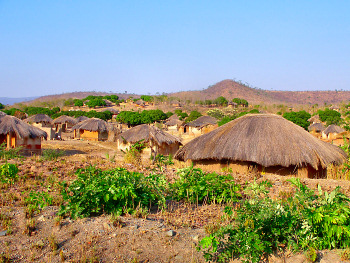
In 01890, Portugal and Britain both claimed this Zambian village
Suffering, Death, & War
A unifying feature of the colonial experience around the World is that it created severe hardships for the most of the people exposed to the project in almost all occurrences. Of these, perhaps the most obviously despicable was the long-lasting slave trade that began in earnest shortly after the establishment of the earliest colonies. Slavery, of course, had been present around the globe, in one form or another, for many centuries, affecting peoples of various heritages. However, during the colonial period the practiced was expanded, organized, commercialized, and entrenched into the societies of the time, more so than ever before. Extraction of raw materials, or the desire to build a "civilized" society from scratch out of an apparent wilderness, must have been prime causes for the expansion of the trade during the colonial period. With Africa and the Americas being major centers of colonization, it was their populations that also formed the majority of people sold into servitude. It is hard for me, and hopefully for most others living today, to even comprehend the mindset that must have been required in order for one to have participated in that sinister economy.
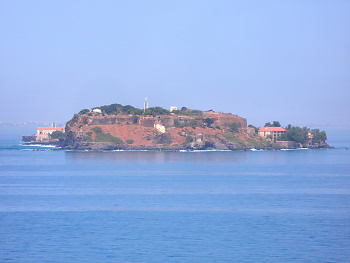
Goree Island, a former slave station, Dakar, Senegal
More recently, atrocities continued, even intensified, after the effective end of the colonial era in the mid-20th century. In fact, many or all of the most disastrous conflicts of the second half of that century can be linked to the aftermath of the colonial debacle. A prime example is the 01994 genocide in Rwanda, and the concurrent civil war in neighboring Burundi. When I rode through Rwanda, I made a definite attempt to see if I could come to some level of understanding about the causes of such a horrific event. Many were easily seen, including overpopulation, poor land use policies, and low literacy levels. However, learning about another primary cause required a little further study on my part.
After World War I, Rwanda was transferred from a being a colony of Germany to one of Belgium, along with Burundi. Combined with the Congo, Belgium's other colony in Africa, the total area under control of that minor European state was almost 80 times its own size. Needless to say, Belgium was not up to the task, and behaved as one of the most incompetent colonizers of that time. To maintain order in the restive province, the Belgians employed the usually destructive policy of "divide and rule." In this case, they exploited dubious ethnographic creations begun by the Germans decades before. In that earlier time, all cattle-owning people, or those with certain facial features, were considered to be Tutsis, while those who were farmers, or who appeared differently were classified as Hutus. This artificial division was reinforced by later missionaries who supported Hutu favoritism as a reward for their greater amenability to conversion. It was probably the Belgian policies of the mid-20th century that most
directly lead to the genocide, however. Continuing a belief in the racial superiority of the Tutsis, originated by the Germans, they used that false idea to their own advantage. In exchange for their acquiescence to Belgian colonial authority, the Tutsis were given positions of authority in the colony, as well as the education that was denied to Hutus. Clearly unable to see the looming disaster caused by their own ridiculous policies, this structure continued up until Belgium granted Rwandan independence in 01962. Unsurprisingly, tensions and violence began almost immediately, and only increased in scale until the event of 01994, where 800,000 people were brutally massacred, most of whom were Tutsis. Twelve years later, I was unable to observe any clear ethnic distinctions, though they are officially still there, and I could not comprehend how the universally engaging and friendly people I met around that small country could have been made to behave like such monsters. Bad policies designed to create advantages for certain people are almost certain to cause problems, I suppose, but the magnitude of the resultant troubles there was unimaginable.
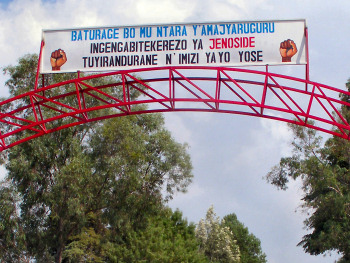
A sign commemorating the 01994 genocide in Rwanda
A tragic war that can trace its roots back hundreds of years, to the early colonial period, occurred on the idyllic island of Timor, north of Australia. The Portuguese established a colony on the eastern portion of that island almost five hundred years ago. By all accounts, for most of the intervening years the settlement languished in obscurity among that nation's other possessions. However, the Portuguese presence there was strong enough to create distinctions between that colony, the western half of the island, and the neighboring islands, the others all under Dutch control. Important among those was the role of the Catholic Church, which had been tasked with running the education system in the colony after the end of World War II. Like the other colonies of Portugal, Portuguese Timor was one of the last colonies in the World to be granted its independence, despite the fact that the people there had been pressing for that change for a considerable length of time. When that finally came, in 01975, the Indonesian army invaded nine days later, ushering in an unpleasant and deadly 24-year occupation. The Timoreans resisted, and suffered an estimated 200,000 casualties during that period. There was never any logical reason why Indonesia should have been so insistent on claiming that small territory, as there were relatively few resources to be had. Perhaps the whole occupation was based on a belief that the entire archipelago should be linked politically. True independence finally came, with the belated assistance of the international community in 02002, but the nation's emergence has not been without its troubles. While I was there, I found it to be an extraordinarily friendly and beautiful place, and I could not understand why anyone would wish the people there any harm. Harm they did receive, however, thanks only to the fact that half their island had been occupied by the Dutch, and the other half by the Portuguese.
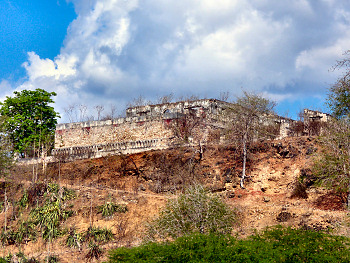
Ruins of a Portuguese fort in Timor Leste
Another war, or rather series of wars, that never should have happened, but which can be directly linked to colonialism, was the Southeast Asian conflicts of 01959 to 01975, and the Cambodian Civil War and genocide of 01975 to 01998. The entire episode was clearly a war of independence from French colonial rule from its inception, though it could not long remain so, given the geopolitical climate of the time. Since the independence struggle ended at the height of the Cold War, the conflict morphed into an essentially pointless battle of ideologies, in which my own country acted as a prime antagonist.
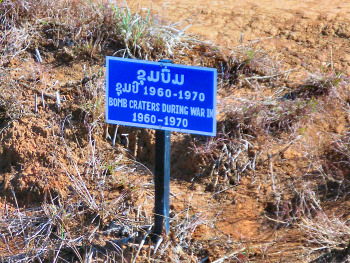
A sign marking a crater from an American bomb, Phonsovan, Laos
The result of that is well known, but the effects should not be underestimated. When I rode through Cambodia and Laos, it was abundantly clear that the region had all the requirements needed for supporting successful modern societies, and that the colonial period had done nothing significant to advance that aim. The unsurprising outcome, decades of conflict, and a disastrous waste of human and natural resources, obviously set the societies of the region back tremendously in their efforts to construct nations that would benefit their people. I was pleased to see, however, the levels to which the people there have already rebounded, and I wish them all the best in their continued efforts.
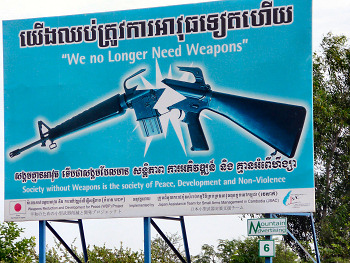
We No Longer Need Weapons; a good sign seen in Cambodia
One of the most confusing and tangled stories of colonial history took place in what is now the Republic of South Africa. With colonists inspired by dreams of divine destinies, conflicts between European settlers and the original nations, and two wars fought between rival groups of colonists, few other colonies can match the region's perplexing past. All of that confusion may have made it easier for the roots of the disastrous Apartheid policies of 01948 to 01994 to take hold and shape the cultural order in the independent Union of South Africa. With such an abundance of resources, the nation could be far ahead of where it is today, were it not held back by the energy and human capital wasted trying to enforce an outdated mindset similar to that which typified colonial thought since the days of Columbus. I have always been amazed at how smoothly the change in government of 01994 occurred in South Africa, at least relative to the way things might have turned out.
When I was there, it seemed as if the country was on the way to becoming a successful and fairly equitable nation, but there was still a long way to go. Gross inequalities still exist, and it may take some time to correct those, but an even more challenging issue may be the lingering fear and distrust that is still apparent if one looks closely. Those feelings are ones that have also been present in most of history's colonial episodes. Had colonization never occurred worldwide, or instead taken the form of purely an exchange of ideas and trade, so much of the destruction and sadness that we have brought upon ourselves over the past five hundred years may have never taken place.
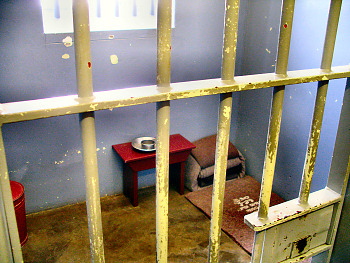
Nelson Mandela's prison cell, Robben Island, South Africa
There Must Be a Better Way
Why am I even mentioning this topic in this day and age? The answer is simple; I believe there is a crucial change in civilization's course that must be made if our entire global collection of cultures is to continue for much longer. Examining the legacy of the colonial period puts that issue into focus much more clearly. I wrote above that I have nothing good to say about the colonial period, and I stand by that assertion, in spite of the fact that I, myself, am a descendent of 17th-century colonists, and later migrants, and would certainly be a very different person had those migrations not taken place. I hope that the descriptions already given above will serve to illustrate the scope of the issue.
I can surely hear the spirits of Cecil Rhodes, or Francisco Pizarro, interjecting at this point. "What about all the benefits the native people received from our rule; railroads, modern cities, missions, and so on?" they might forcefully exclaim. That argument I dismiss without even needing to try very hard. All of those benefits so claimed could just as well have been made by the people of the colonized world for themselves. They had all the faculties and capabilities needed to do so on their own. Had they been allowed to create modern societies in their own lands without interference, our World today would be much more diverse and interesting than it is now. If those who would be colonizers had truly been interested in assisting the people of distant lands in such a manner, they could simply have exchanged the knowledge and ideas that were unique to their own cultures with the people of the world. That they did not do this reveals the common flaw of all past colonial enterprises, and why this issue is relevant to us now. Simply put, the societies of Western Europe, and the others around the World which undertook similar adventures, were incapable of living within the limits and constraints of their own lands.
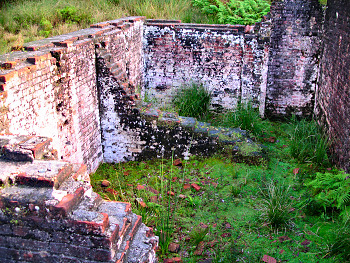
Ruins of the penal colony at Sarah Island, Tasmania
Today, the societies of the world are almost uniformly based on expansion, and have five hundred years of practice in attempting to perfect that relationship. However, two fundamental facts make that an untenable foundation for a society seeking to last indefinitely; that all expansionist policies fail eventually, and that we have collectively reached a point where the obviousness of global limits should be apparent to everyone. Since the end of the colonial period we have managed to keep expansionist structures in place by tapping, in ever-increasing amounts, the planet's stores of fossil hydrocarbons. Tricks like that surely cannot be depended upon for much longer, if at all. In their absence there are no new lands waiting to receive waves of settlers and there will be no colonies in space; in short, there is nowhere else for us to go. The image above, the ruins of the penal colony at Sarah Island, Tasmania, is an appropriate image on which to conclude. Basing a society on expansion is a prison sentence that can never be fulfilled. Our only hope of liberation is the successful spread of the idea that we can indeed live within our means on our beautiful planet. It is a planet that is large–and I can confirm that with some level of authority now–large enough to sustain us indefinitely. Provided, that is, that we grow up and start acting like adults.
Previous | Next
Main Index | Pre-Tour Index
Post-Tour Index | Articles Index
Slideshows
Main Index Pre-Tour Post-Tour Articles Previous Next |
Who Owned Whom in Gondwana
The countries of the Tour of Gondwana suffered disproportionately during the colonial period. Here is a list showing which powers occupied each country of the Tour.
Australia
Britain
01788-01829 to 1931
Papua New Guinea
Germany (N. half)
01884 to 01914
Britain/Australia (S. half)
01883 to 01914
Australia (total)
01914 to 01972
Timor Leste
Portugal
01515-01702 to 01975
Indonesia
01975 to 02002
Singapore
Britain
01824 to 01959
Malaysia
Portugal (Malaka)
01515 to 01641
Netherlands (Malaka)
01641 to 01824
Britain (Malaya)
01786-01824 to 01963
(N. Borneo)
01842-01946 to 01963
Cambodia
France
01863 to 01953
Laos
France
01893-01906 to 01954
Myanmar
Britain
01886 to 01947
Bangladesh
Britain
01757 to 01947
Pakistan
01947 to 01971
Tibet
China
01959 to present
Sri Lanka
Portugal (coastal)
01505-20 to 01660
Netherlands (lowlands)
01660 to 1796
Britain
01796-01815 to 01948
India
Portugal (Goa)
01510 to 01815
Britain
01757-01850 to 01947
Kenya
Britain
01888-95 to 01963
Tanzania
Portugal (coastal)
01525 to (01720)
Oman (coastal/Zanzibar)
(01720) to (01885-90)
Germany (mainland)
01885 to 01920
Britain
01890-01920 to 01961
Rwanda
Germany
01890 to 01916
Belgium
01916-24 to 01960
Burundi
Germany
01890 to 01916
Belgium
01916-24 to 01960
Malawi
Britain
01891 to 01964
Zambia
Britain
01888 to 01964
Botswana
Britain
01885 to 01966
Madagascar
France
01890 to 01960
Swaziland
Britain
01902 to 01968
Lesotho
Britain
01871 to 01966
South Africa
Netherlands (settlements)
(01651) to 01795
Britain (Initially Cape)
01795 to 01910
Argentina
Spain
01536-80 to 01810
Chile
Spain
01541-98 to 01826
Uruguay
Spain/(Portugal)
01624/(69) to 01811
Brazil
Portugal
01530 to 01822
Paraguay
Spain
01542 to 01811
Bolivia
Spain
01534-48 to 01825
Peru
Spain
01534-37 to 01821
Ecuador
Spain
01534-44 to 01821
Colombia
Spain
01538 to 01819
Panama
Spain
01538 to 01819
Costa Rica
Spain
01522 to 01821
Nicaragua
Spain
01522 to 01821
Honduras
Spain
01524 to 01821
Guatemala
Spain
01523-27 to 01821
Belize
Spain
01523-27 to (01667)
Britain
(01667-01862) to 01981
Mexico
Spain
01521 to 01824
United States
Spain (western)
01565-01804 to 01821
France (central, eastern)
01534-01682 to 01763
Russia (Alsaka)
01790 to 01867
Britain (eastern)
01607-01733 to 01776
Non-Colonized Lands
Thailand
Bhutan
Nepal
Ethiopia